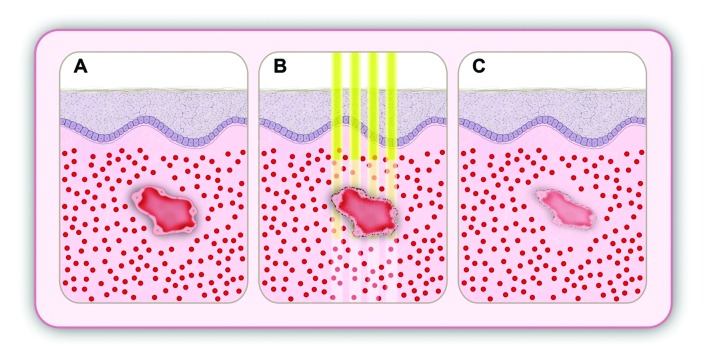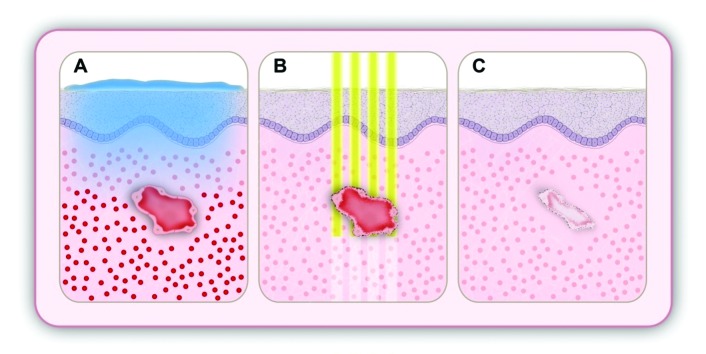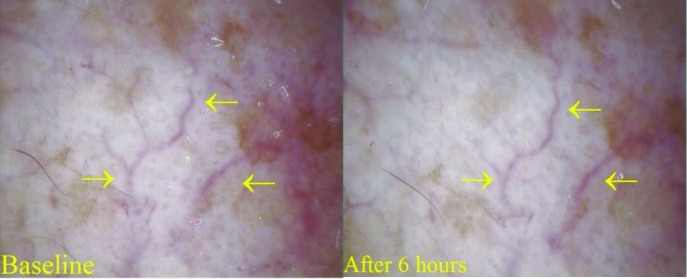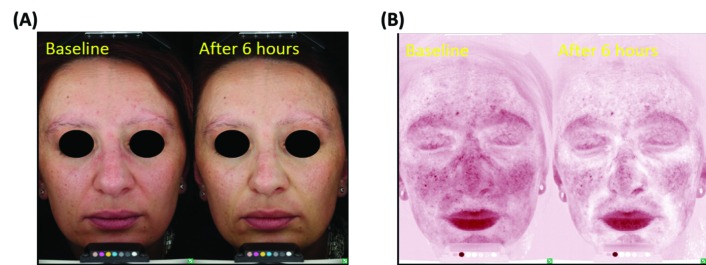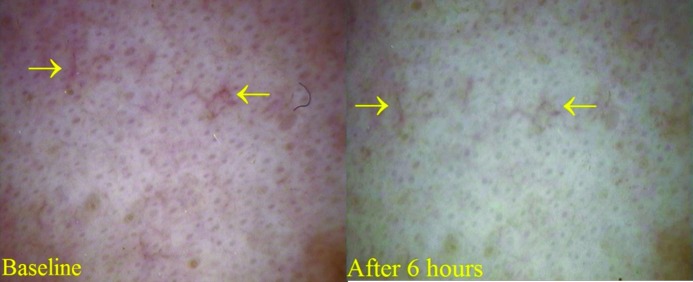Abstract
Rosacea is a chronic inflammatory disease that can present with a variety of cutaneous symptoms. Erythematotelangiectatic rosacea is a subtype characterized by flushing (transient erythema), persistent central facial erythema (background erythema), and telangiectasias. The severity of individual symptoms differs in each patient, which can complicate the selection of an appropriate treatment strategy. Evaluation of these specific symptoms has been greatly improved by the routine use of diagnostic tools such as (video) dermatoscopy. Following a thorough clinical assessment, treatment decisions should be made based on the proportion of these individual symptoms in individual patients. Brimonidine 0.33% gel is recommended in the symptomatic treatment of facial erythema, and there is evidence for the efficacy of laser/light-based therapies in the treatment of erythema and telangiectasias. In patients presenting with both marked background erythema and telangiectasias, initial treatment with brimonidine 0.33% gel to target the erythema followed by laser/light-based therapy for the telangiectasias has been shown to be an effective combination in clinical practice. This article aims to facilitate treatment decision-making in clinical practice through: 1) better differentiation of the main symptoms of erythematotelangiectatic rosacea and 2) practical advice for the selection of appropriate treatments, based on clinical case examples.
Rosacea is a chronic inflammatory disease that can manifest as a variety of clinical presentations, with different combinations of cutaneous symptoms, such as flushing, erythema, telangiectasia, edema, papules, pustules, rhinophyma, and ocular symptoms.1 In 2002, an expert panel of the National Rosacea Society published a classification system to help standardize the diagnosis of rosacea into four main subtypes based on the primary and secondary characteristics present: erythematotelangiectatic rosacea (ETR), papulopustular rosacea, phymatous rosacea, and ocular rosacea.2 Although patients usually present with a spectrum of symptoms overlapping these subtypes, the current standard of care is to treat according to subtype rather than symptoms.3-5 To effectively target the disease, there is a need to treat the individual symptoms in each patient.
ETR is defined by the presence of different symptoms that may overlap with those of other rosacea subtypes.2,6,7 The primary features of ETR are flushing (transient erythema), persistent central facial erythema (background erythema), and appearance of telangiectasias (i.e., dilated small blood vessels).2 Of note, erythema is often cited by patients as being the most bothersome symptom.8 Other symptoms, such as central facial edema, stinging and burning sensations, and scaling, have also been reported.2 This article aims to facilitate treatment decision-making in clinical practice, through better differentiation of the main symptoms of ETR, background erythema, and telangiectasia. Practical advice on the most appropriate sequence of treatments, based on individual patients’ clinical features, will also be provided.
HISTOLOGIC AND PATHOPHYSIOLOGICAL FEATURES OF ETR
Histologic features of ETR. Microscopic examination of ETR biopsies typically shows non-specific features. One important characteristic change, however, is the presence of enlarged, dilated, non-lymphatic capillaries and venules in the upper- and mid-parts of the dermis, which frequently present with bizarre shapes and are sometimes defined as “tortuous vessels.”9
Mild-to-moderate edema, which is rarely visible to the naked eye, but is almost always present on histology, is responsible for the clear aspect of the upper dermis. Edema in patients with ETR may be due to an increased number of vessels and defective permeability, as well as the discontinuity of endothelial cells.10,11
Inflammation typically occurs throughout the upper, mid, and deep dermis, with density of inflammation varying between individuals and over time.9 The prerequisite inflammatory background in the ETR subtype is both perivascular (surrounding dilated vessels) and interstitial inflammation.9 Erythema might appear slightly elevated, with a dense infiltrate around the capillaries and venules of the upper dermis.9 The inflammatory infiltrate is mainly composed of lymphocytes,9 of which the majority are CD3+ T cells (70-80%), with an important proportion of CD20+ B cells (10-20%). T lymphocytes appear mainly as CD4+, with a minor CD8+ population (<30%). An increase in the number of mast cells is also observed.12 Plasma cells are frequently seen and might be an important clue to disease diagnosis.9,13
Pathophysiology of ETR. A variety of pathophysiological mechanisms have been linked with the different clinical presentations of rosacea, including an augmented innate immune response and neurovascular dysregulation.5 The pathophysiology of ETR is characterized by inflammatory infiltration and upregulation of inflammatory cytokine genes, leading to cross-talk mechanisms between innate immune response and neurogenic inflammation.14 Marked upregulation of proinflammatory and vasoregulatory genes and presence of perivascular inflammatory infiltrate is observed in patients with ETR, even in those at the early stages of the disease, suggesting early involvement of innate immune response.15
In addition to the presence of inflammatory infiltrate, dilation of cutaneous vasculature and lymphatics are hallmarks of ETR, with affected skin having been shown to exhibit increased cutaneous blood flow.16-21 Enlargement of vasculature, hyperpermeability and fluid extravasation are characteristic of tissue inflammation, accompanied by heightened angiogenesis and lymphangiogenesis, and increased expression of blood vessel (CD31) and lymphatic (D2-40) markers, as well as endothelial growth factor (VEGF)-A.16,17,19 Changes in vascular integrity and chronic VEGF-A stimulation of blood vasculature causes vascular remodeling, increased vascular permeability and increased expression of adhesion molecules.19
A variety of stimuli (e.g., heat exposure, hot temperature, exercise, spicy foods, and alcohol ingestion) can trigger a heightened vasodilatory response of facial skin, likely primarily neurogenic in origin, in patients with ETR.22 Evaluation of neurovascular and neuroimmune changes demonstrates the major vasodilation of blood vessels (with diameters lower than 200μm23) and lymphatics in ETR,24 confirms the upregulation of genes involved in vasodilation, and corroborates the observation that blood vessels retain their ability to respond to vasoactive stimuli.24 Dysregulation of components required for neurovascular and neuroimmune communication may be crucial at early stages of rosacea.24 Neuroimmune and neurovascular effects are therefore major pathophysiological factors in ETR, using cross-talk mechanisms between an augmented innate immune response and neurogenic inflammation at different time points in the course of disease progression.22
Rosacea as an inflammatory disease. Genetic profiling and histological evaluation do not support a microbial source as the initiating pathophysiological factor in the early stages of rosacea. This provides additional evidence that rosacea is an inflammatory disease characterized by accentuation of innate immune response associated with multiple triggers and dysregulation of several interactive cutaneous systems and/or pathways.22 These include enhanced innate immunity related to increases in some matrix metalloproteinases (MMPs), leading to increased expression of toll-like receptor 2 (TLR2), cathelicidin, cathelicidin-derived peptides (LL37) and serine proteases (kallikrein [KLK]-5) in keratinocytes; stratum corneum permeability barrier dysfunction resulting in increased central facial transepidermal water loss (TEWL) and skin sensitivity; and dysregulation of neuroimmune and neurovascular activities, including alterations in mediators and receptors, as well as some changes in density of mast cells and sensory nerves.22
ASSESSMENT OF THE CLINICAL FEATURES OF ETR IN CLINICAL PRACTICE
Clinical presentations of ETR. The facial erythema of rosacea relates to a combination of different factors, with some common underlying pathophysiological factors present in most patients.
Central facial erythema, or background erythema, is most often confluent and diffuse, and may be softly edematous in some patients.5 In most cases, background erythema is located on the inner cheeks, nose, chin, and/or mid forehead; involvement of the peripheral face may also be present.5 As evidenced in Figure 1, during flares of rosacea, the diffuse background erythema intensifies in magnitude of redness, with characteristic, demarked borders. During these periods, background erythema is often more symptomatic (i.e., burning or stinging) and may even become edematous.5
Figure 1.
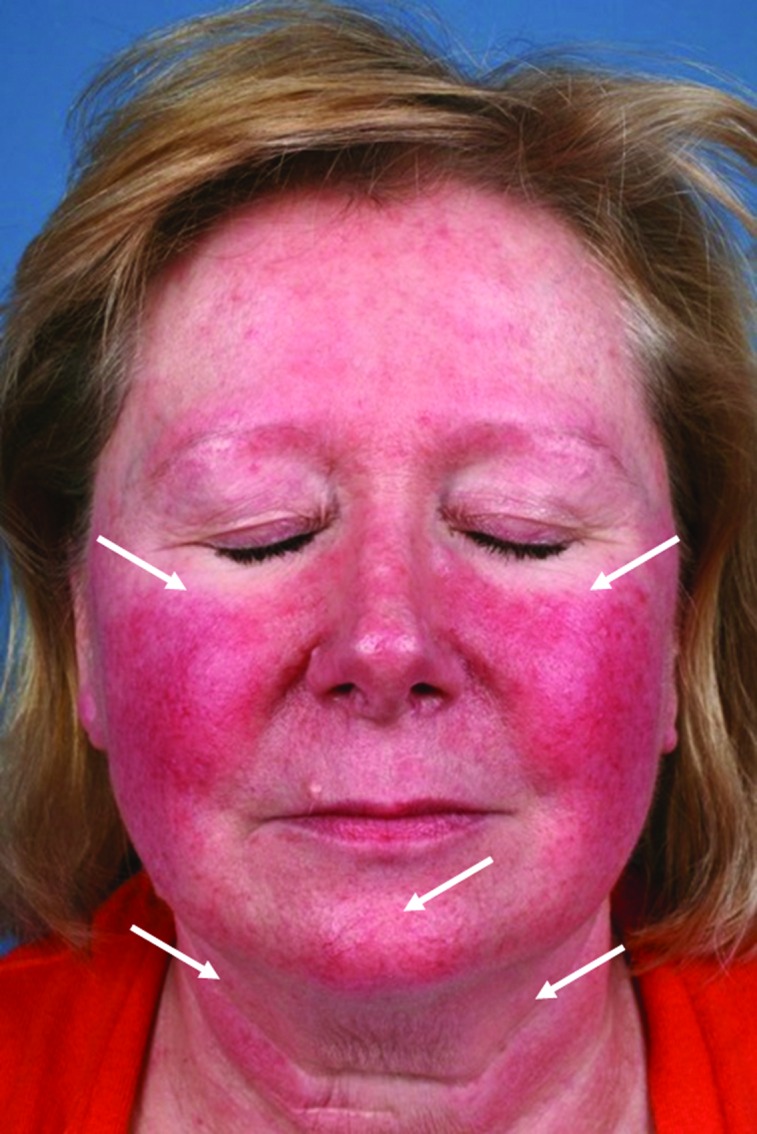
Erythematotelangiectatic rosacea during a flare
It is important to differentiate central facial, background erythema from perilesional erythema, which relates to the flare of redness that focally surrounds individual inflammatory lesions and may be present in some patients with overlapping symptoms. Background and perilesional erythema are two separate clinical manifestations caused by different pathophysiological factors, and therefore need to be managed accordingly. Agents that decrease papulopustular lesions and their associated perilesional erythema may potentially counteract some of the rosacea-associated vascular inflammation and dilation, but they will have a negligible, or even no effect in terms of decreasing diffuse background erythema, which is caused by permanently altered superficial cutaneous vasculature.5
This permanently altered vasculature, which occurs secondary to inflammation, manifests as dilated and enlarged facial blood vessels, enlarged vascular nets, and telangiectasia formation.5 When such visible manifestations associated with a flare of rosacea are present, the pathogenic mechanisms that lead to vasodilation, increased blood flow and augmentation of cutaneous inflammatory pathways, are activated. This, in turn, results in visibly accentuated background erythema, with variable degrees of soft edema.5 It is important to differentiate this clinical presentation from telangiectatic photoaging, which has recently been shown to be a distinct dermatologic disorder with different clinical, histopathologic features and gene expression pattern from ETR.25
Clinical evaluation of ETR. Estimation of the severity and course of rosacea is currently based on clinical evaluation.26 Development of techniques allowing for better visualization of vessels will enhance clinical assessment of disease severity, physical course, and response to treatment. Importantly, it will allow for better differentiation of telangiectasia from background erythema.26
A simple way to assess superficial erythema is to press the fingertip against the skin and withdraw it quickly to determine whether blanching occurs. Diascopy is a simple clinical test to confirm this initial assessment. A glass spatula is pressed against the skin, which empties the blood from the superficial vessels and helps to determine whether skin redness is due to blood within vessels, i.e. telangiectasia, or other causes. If a telangiectatic vessel is present, it will blanch with pressure remaining visible, whereas any background erythema should completely disappear.27
Polarized light photography using a modified standard digital camera is a more robust technique to investigate erythema and blanching. This technique, which works by removing the polarization-retaining light reflected from the epidermal layer, has proved useful in the clinical evaluation of ETR in practice in recent years.28 Polarized digital photography may also be equipped with a technology that enables separation of the unique color signatures of red skin components (RBX system); this erythema-directed imaging is able to highlight the red areas corresponding to increased vascular flare.28-30
Dermoscopy is a noninvasive technique mainly utilized for the evaluation of pigmented skin lesions using x10 magnification. It may also improve visualization of vessels and color changes that are difficult to recognize with the naked eye. In recent years, this technique has provided some evidence to help in the differential diagnosis of inflammatory/erythematous skin disorders.26,31,32 Vascular changes presenting with the so-called pattern of polygonal vessels, is a common dermoscopy finding of ETR (Figure 2a).31,32 An accurate assessment of clinical improvement after treatment can be established based on the modifications of these polygonal vessels.26
Figure 2.
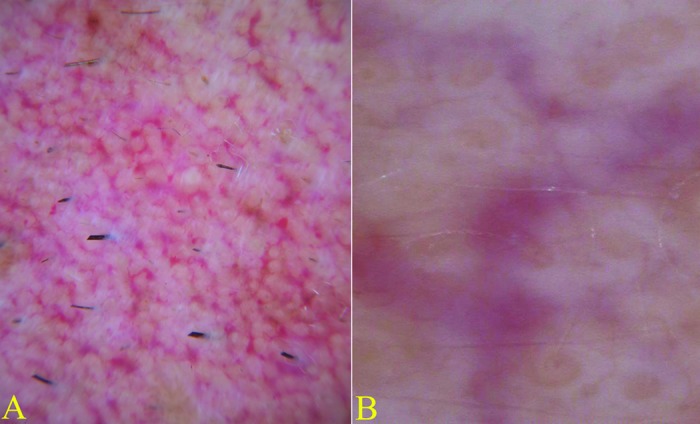
Erythematotelangiectatic rosacea by dermoscopy and videodermatoscopy. (A) ×10 dermoscopy; (B) ×150 videodermatoscopy of erythematotelangiectatic rosacea revealing the presence of enlarged, polygonal vessels
A better visualization of the vascular pattern may be obtained using videodermatoscopy or videocapillaroscopy, which allow higher magnification up to x1000. These techniques may represent valid adjunctive tools in the early identification and measurement of ETR, as they can show specific and measurable vessel alterations.18,33 Using these techniques, the skin affected by ETR usually shows larger vessel diameter compared with unaffected skin, as well as more prominent telangiectasias (defined as vessels larger than 100μm), neoangiogenesis, and large capillary nets (polygons, Figure 2b).18
TREATMENT OF ETR IN CLINICAL PRACTICE
In clinical practice, patients may present with different proportions of the two main manifestations of ETR, background erythema and telangiectasia, and treatment will need to be adapted to the manifestation that is being targeted, as well as to each individual clinical presentation.
Brimonidine tartrate gel. Prior to the introduction of brimonidine tartrate gel, there were no approved topical treatments for facial erythema of rosacea.4 Brimonidine 0.33% gel (Mirvaso®, Galderma Laboratories L.P.) is approved for the symptomatic treatment of facial erythema in adults with rosacea; one gram of gel contains 3.3mg of brimonidine, which is equivalent to 5mg of brimonidine tartrate (0.5%).34
Brimonidine tartrate, a highly selective α2-adrenergic receptor agonist, is 1000-fold more selective for the α2-adrenergic receptor than the α1-adrenergic receptor.34 Direct vasoconstriction of both small arteries and veins has been established, with brimonidine tartrate demonstrated as a more specific and five-fold more potent vasoconstrictor of human subcutaneous vessels <200pm in diameter than oxymetazoline, a selective α1-adrenergic receptor agonist and partial α2-adrenergic receptor agonist.23 Unlike oxymetazoline, however, brimonidine tartrate is inactive against the 5-hydroxytryptamine 2B receptor (5-HT2B), which has been reported to be involved in valvular heart disease after long-term treatment.23,35
Interestingly, it has also been shown that brimonidine tartrate displays anti-inflammatory properties, based on the inhibition of edema (when compared to vehicle) in in vivo murine models of ear inflammation. However, the implications of the anti-inflammatory action of brimonidine tartrate on the course of disease require further investigation.23
Efficacy and safety of brimonidine 0.33% gel in clinical trials. The efficacy and safety of brimonidine 0.33% gel in the treatment of patients with moderate-to-severe erythema of rosacea have been evaluated in several Phase 2 and 3 clinical trials. In these studies, the severity of erythema was measured using the clinician’s erythema assessment (CEA) and patient’s self-assessment (PSA) scales.36-40 In two multicenter, randomized, double-blind, parallel-group, vehicle-controlled Phase 3 studies, brimonidine 0.33% gel was shown to provide significantly greater efficacy (defined as a two-grade improvement in both CEA and PSA over 12 hours) than vehicle at 30 minutes for Days 1, 15, and 29. In both studies, brimonidine 0.33% gel once daily showed significantly greater efficacy compared with vehicle for all efficacy endpoints, with a faster onset of action and good safety and tolerability profiles.37 In a separate open-label, multicenter study, the long-term safety and efficacy of brimonidine 0.33% gel once daily was evaluated over 12 months.39 Similar to the Phase 3 studies, effects were seen on Day 1 following the first application of brimonidine 0.33% gel (CEA decreased from 3.1 at baseline to 1.7 at Hour 3). The majority of adverse events were dermatologic in nature and mild to moderate in intensity, with the highest incidence of adverse events related to treatment during the first quarter of the study, which decreased substantially during the second quarter, and declined further for the remaining duration of the study.39 Following a recent meta-analysis review in 2015, it was found that there was high-quality evidence to support the effectiveness of topical brimonidine for rosacea.41
Laser and light-based therapies. Laser and light-based therapies are currently state-of-the-art for the treatment of telangiectatic erythema,41 with a variety of devices targeting hemoglobin reported to be effective, including the 595nm pulsed dye laser (PDL), the 532nm potassium titanyl phosphate (KTP) or lithium triborate (LBO) laser, the 1064nm neodymium-doped, yttrium-aluminium-garnet (Nd:YAG) laser, and non-coherent intense pulsed light (IPL) sources (500-1200nm).42 Longer wavelengths are effective for targeting deeper vessels, while shorter wavelengths target more superficial vessels.42
The major chromophore in blood vessels is oxyhemoglobin, with two major absorption bands in the visible light spectrum at 542 and 577nm. Following absorption by oxyhemoglobin, light energy is converted to thermal energy, which diffuses in the blood vessel, causing photocoagulation, mechanical injury, and finally thrombosis and occlusion (Figure 3).42
Figure 3.
Impact of laser/light-based monotherapy on telangiectasia and background erythema in erythematotelangiectatic rosacea. (A) In a patient with erythematotelangiectatic rosacea, telangiectasia and background erythema are present; (B) Energy administered by laser/light-based therapies is actively taken up by hemoglobin in telangiectatic blood vessels; (C) Laser/light-based monotherapy causes vessel destruction, but has minimal effects on background erythema.
The PDLs, with wavelengths of 585 to 595nm, have circular or oval spot sizes that are ideal for the treatment of dermal vessels. PDLs target hemoglobin and deliver all of the administered energy in a wavelength that is actively taken up by the hemoglobin in blood vessels, causing vessel destruction.41 A 75-percent reduction in telangiectasia score was seen in patients with rosacea (n=12) after a mean of three treatments with the 585nm PDL (450us pulse durations).43 In another study in 18 patients with nasal telangiectasias resistant to the traditional round-spot, 595nm PDL and/or 532nm KTP laser who were treated with ultra-long pulse (40ms pulse duration and double passes), 595nm PDL with a 40ms pulse duration and double passes, complete clearance was seen in 10 (55.6%) participants, with eight (44.4%) participants showing more than 80-percent improvement.44
The use of KTP laser (532nm) is limited to light skin types due to its high melanin absorption, which can lead to epidermal damage with postinflammatory hyper-pigmentation. Based on its short wavelength, the KTP laser is best used to treat superficial telangiectasias.42 In a split-face study (n=15) comparing the efficacy of 595nm PDL and 532nm KTP laser, the KTP laser achieved 62-percent clearance after the first treatment and 85-percent clearance three weeks after the third treatment, compared with 49 and 75 percent, respectively, for the PDL. However, the degree of swelling and erythema post-treatment were both greater on the KTP laser-treated side.45
The main disadvantage of PDLs is the development of post-treatment purpura, a rash of purple spots on the skin caused by internal bleeding from small blood vessels.42 The longer pulse durations of KTP lasers avoid damage to cutaneous vasculature and eliminate the risk for bruising. However, the wavelength of the PDL provides a greater depth of penetration due to its substantial absorption by cutaneous vasculature versus the shorter wavelength of the KTP laser.42 Although newer-generation PDLs still have the potential to cause purpura, various attempts have been made to minimize this risk, such as the use of longer pulse durations.46 Separate parameters may need to be used when treating linear vessels and diffuse erythema, with longer pulse durations required for larger vessels.42
The wavelength (1064nm) of the Nd:YAG laser targets the lower absorption peak of oxyhemoglobin.42 Among 15 patients with facial telangiectasia treated at Day 0 and Day 30 with a 1064nm Nd:YAG laser (fluence: 120 to 170J/cm2; pulse duration: 5-40ms; spot size: 3mm), 73 percent (11/15) showed moderate to significant improvement at Day 0 and Day 30 and 80-percent improvement at three months of follow-up.47 In a split-face study (n=14) comparing the 595nm PDL (fluence: 7.5J/cm2; pulse duration: 6ms; spot size: 10mm) with the 1064nm Nd:YAG laser (fluence: 6J/cm2; pulse duration: 0.3ms; spot size: 8mm), erythema improved by 6.4 percent from baseline on the side treated with the PDL. Although participants rated the Nd:YAG laser treatment as less painful, they were more satisfied with the results of the PDL treatment.48 In another split-face study comparing these two treatment modalities, greater improvement was reported with the Nd:YAG laser, although the results were not statistically significant.49
Unlike lasers, which use selective photothermolysis, IPL devices emit non-coherent light at a wavelength of 500 to 1200nm.42 Cut-off filters allow for selective tissue damage depending on the absorption spectra of the tissue. Longer wavelengths are effective for the treatment of deeper vessels, whereas shorter wavelengths target more superficial vessels. However, because the shorter wavelengths can interact with melanin, their use should be avoided in dark skin types.42 In 34 patients with ETR (flushing, erythema, and telangiectasia) treated with IPL (560nm cut-off filter, fluences: 24-32J/cm2), mean reduction of total erythema following four treatments was 39 percent on the cheeks and 22 percent on the chin, with minimal side effects.50
Combination therapies. Despite the effectiveness of laser/light-based therapies in targeting telangiectasia, the effects of these treatments on background erythema or rosacea-associated flushing are limited. In order to achieve sufficient reduction of background erythema, a treatment course including several procedures is required, with the results achieved lasting from several weeks up to years. Nevertheless, a distinct subset of patients with “laser/light-based-resistant” background erythema will not benefit from laser/light-based therapies. Brimonidine 0.33% gel treatment, on the other hand, has an immediate effect on the erythema component, with clinically meaningful effects being observed after 30 minutes following first application34; however, this agent is not indicated in the treatment of telangiectasia.
Therefore, laser/light-based therapies and brimonidine 0.33% gel target different symptoms of ETR and act via different mechanisms/through different approaches. ETR patients with prominent telangiectasia will significantly benefit from laser/light-based therapies, and treatment with topical brimonidine 0.33% gel will be effective to treat those patients with prominent background erythema. To achieve maximum patient satisfaction in the majority of ETR patients who present with background erythema and telangiectasia, the authors propose a combined approach of sequential treatment with pharmacological and laser/light-based therapies.
Unmasking target lesions. In the clinical setting, the intensity of background erythema may impair the discrimination of telangiectasia. In addition, the energy delivered by laser/light-based treatments targets hemoglobin independently of the symptoms present (telangiectasia and background erythema). Hence, during treatment, laser/light energy is also transferred to background erythema, even though the therapeutic effect is often limited.
Accordingly, treatment with brimonidine 0.33% gel prior to laser/light-based therapy will 1) “unmask” telangiectasia from background erythema, thereby enabling a more lesion-directed therapy and 2) increase laser/light-based therapy efficacy on telangiectasia, as less energy will be absorbed unselectively by background erythema (Figure 4). Furthermore, nonselective absorption may potentially be associated with an increased level of complications of laser/light-based therapy due to an unspecific (bulk) heating of the tissue surrounding the vessels. Therefore, the authors propose that application of brimonidine 0.33% before laser treatment in patients with ETR will make the telangiectasia present more visible, and has the potential to increase the efficacy and safety of laser/light-based therapy (Figure 4).51
Figure 4.
Combined action of brimonidine 0.33% gel and laser/light-based therapies on erythematotelangiectatic rosacea with prominent telangiectasia and background erythema components. (A) Topical application of brimonidine 0.33% gel to patients with erythematotelangiectatic rosacea with prominent telangiectasia and background erythema; (B) Brimonidine 0.33% gel targets the background erythema to “unmask” telangiectasia; the energy administered by laser/light-based therapies is actively taken up by hemoglobin in telangiectatic blood vessels, causing vessel destruction; (C) the sequential treatment of topical brimonidine 0.33% gel targeting the background erythema and laser/light-based therapy targeting telangiectasia is an effective option to treat the symptoms of erythematotelangiectatic rosacea.
Applications in clinical practice: treatment decisions based on clinical presentations of ETR. Patient 1 is a 53-year-old Caucasian woman who presented with marked telangiectasia and minimal background erythema (Figure 5). She had been suffering from rosacea for 25 years, but was otherwise healthy. Her symptoms had worsened over time and she had been unresponsive to conventional rosacea treatments. Her response to treatment with brimonidine 0.33% gel was poor, with several telangiectasias persisting six hours after application. In this patient, a suggested approach would be to treat with laser/light-based monotherapy.
Figure 5.
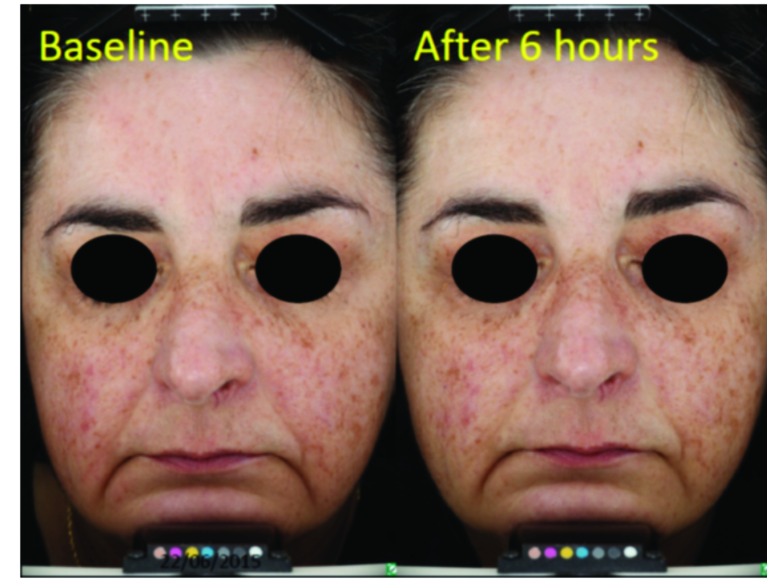
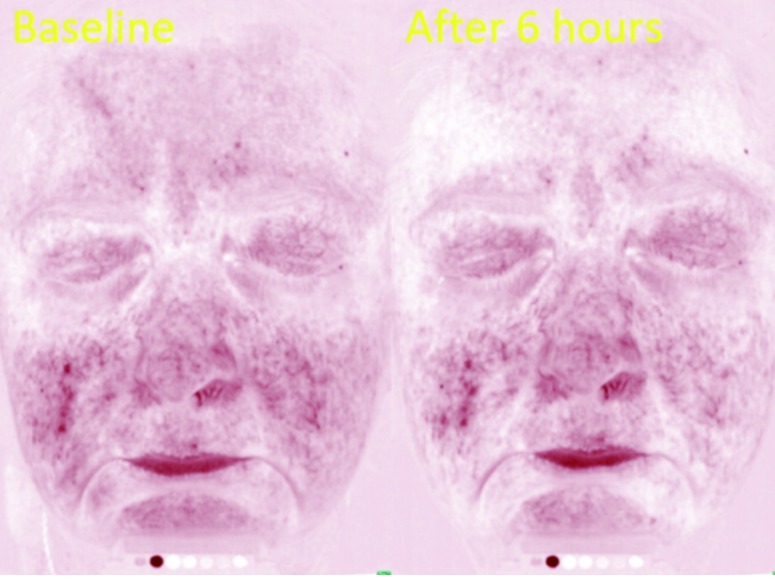
Patient 1: Marked telangiectasia with minimal background erythema. (A) Polarized light photography and (B) erythema-directed photography using VISIA CR system (Canfield, US) of the patient at baseline and 6 hours after application of brimonidine 0.33% gel showing poor response to treatment; (C) ×30 videodermatoscopy at baseline and after 6 hours showing the persistence of telangiectasia (arrows). Videodermatoscopy is a tool enabling the magnification and measurement of vessels in patients with erythematotelangiectatic rosacea.
Patient 2 is a 45-year-old Caucasian woman who had rosacea for 10 years and presented with minimal telangiectasia and marked background erythema. She had received no previous treatments and her concomitant esophagitis had been treated with omeprazole. Her response to brimonidine 0.33% gel was excellent, with only mild background erythema seen six hours after application (Figure 6).
Figure 6.
Patient 2: Minimal telangiectasia with marked background erythema. (A) Polarized light photography; (B) Erythema-directed photography using VISIA CR system (Canfield, US) of the patient at baseline and 6 hours after application of brimonidine 0.33% gel showing a marked reduction of background erythema; (C) ×30 videodermatoscopy at baseline and after 6 hours showing reduction of background erythema and persistence of some telangiectasias (arrows). Reducing the level of erythema helps to visualize the telangiectatic blood vessels present and minimize nonselective absorption, increasing the efficacy of light-based therapy.
Patient 3 is a 60-year-old Caucasian woman, who presented with a complex case of both marked background erythema and marked telangiectasia. She had been suffering from rosacea for 20 years, had been unresponsive to conventional rosacea treatments, and was receiving concomitant treatment of ramipril for cardiac hypertension. Treatment with brimonidine 0.33% gel resulted in visible improvement of background erythema six hours after application, while telangiectasia remained unchanged (Figure 7). In this patient, a suggested management approach would be to use a combination of brimonidine 0.33% gel and laser therapy. Initial application of brimonidine 0.33% gel would reduce the redness, which would “unmask” telangiectasia, making it easier to target it with laser/light-based therapy. It would then be recommended that the patient be given maintenance therapy with brimonidine 0.33% gel, with intermittent use of laser/light-based therapy until background erythema is resolved.
Figure 7.
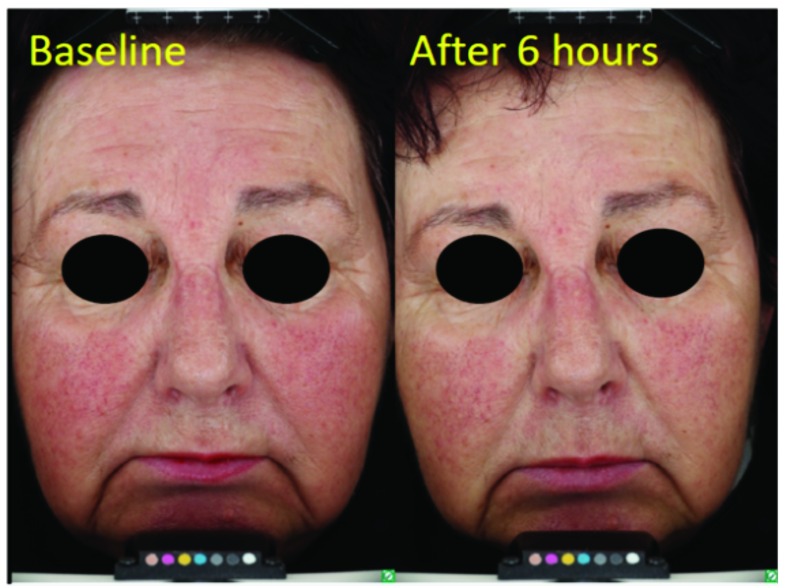
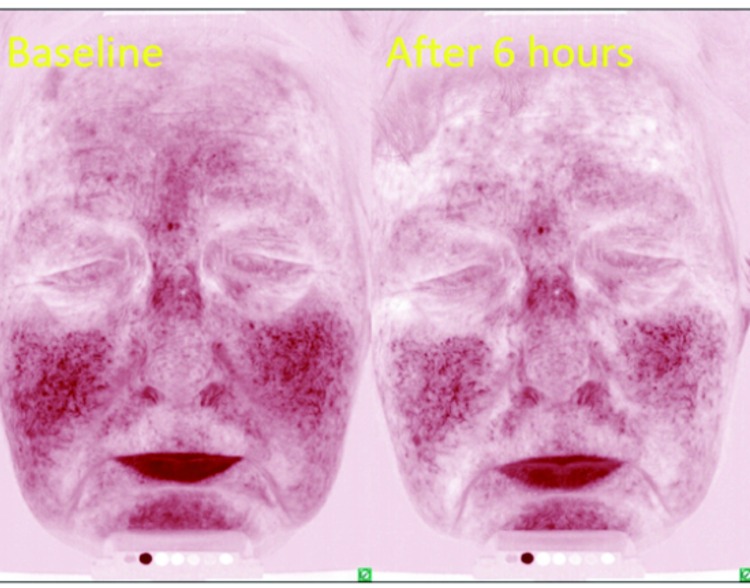
Patient 3: Marked telangiectasia with marked background erythema.
(A) Polarized light photography; (B) Erythema-directed photography using VISIA CR system (Canfield, US); and (C) x30 videodermatoscopy of the patient at baseline and 6 hours after application of brimonidine 0.33% gel showing visible improvement of background erythema and persistence of telangiectasia. Reducing the level of erythema helps to visualize the telangiectatic blood vessels present and minimize non-selective absorption, increasing the efficacy of lightbased therapy.
Table 1 provides a summary of potential different scenarios and suggested management for patients with erythematotelangiectatic rosacea. However, it should be noted that patients will present with different symptoms, which may overlap the different classical subtypes. Therefore, it is essential that treatment is tailored to each patient’s presentation to target individual manifestations of rosacea.
TABLE 1.
Different scenarios and suggested management of patients with erythematotelangiectatic rosacea
| SCENARIO | SUGGESTED MANAGEMENT |
|---|---|
| Marked telangiectasia + Minimal background erythema | Laser/light-based therapy |
| Minimal telangiectasia + Marked background erythema | Brimonidine 0.33% gel |
| Marked telangiectasia + Marked background erythema | Combination brimonidine 0.33% + laser/light-based therapy |
CONCLUSION
As a clearer picture of the histology and pathophysiology of ETR is starting to emerge, it becomes apparent that treatments should address each of its two main clinical presentations, background erythema and telangiectasia. Following a thorough clinical assessment with dermoscopy and polarized light, treatment decisions should be made based on the proportion of each of these two components in individual patients. Brimonidine 0.33% gel is recommended in the symptomatic treatment of facial erythema, and there is evidence for the efficacy of laser/light-based therapies in the treatment of telangiectasia. In patients presenting with both marked background erythema and marked telangiectasia, it is recommended to first treat the erythema with brimonidine 0.33% gel. Following reduction in redness, laser/light-based therapy might be more effective as well as safer, and maintenance therapy with brimonidine 0.33% gel, with intermittent use of laser/light-based therapy until background erythema is resolved, is then recommended. In addition, this approach allows patients to have control over their treatment, as they are not dependent on a course of laser/light-based therapy to be completed, contributing to their overall treatment satisfaction.
Acknowledgment
Editorial assistance in the preparation of the manuscript was provided by Drs. Raffaella Facchini and Carole Mongin-Bulewski of Havas Life Medicom. Support for this assistance was funded by Galderma.
Footnotes
DISCLOSURE:Prof. Micali has been a member of advisory board panels for Abbvie, Bayer, Eli Lilly, Galderma, Meda, Mundipharma, and Pfizer; and received honoraria as a speaker for Galderma. Dr. Gerber has been a member of advisory board panels for Galderma, received travel support from Asclepion Laser Technologies and Galderma, received research support from Galderma, and received honoraria for publications and as a speaker from Asclepion Laser Technologies and Lumenis. Dr. Lacarrubba has no conflict of interest to declare. Dr. Schäfer is an employee of Galderma Laboratories LP.
REFERENCES
- 1.Two AM, Wu W, Gallo RL, Hata TR. Rosacea: part I. Introduction, categorization, histology, pathogenesis, and risk factors. J Am Acad Dermatol. 2015;72(5):749–758. doi: 10.1016/j.jaad.2014.08.028. [DOI] [PubMed] [Google Scholar]
- 2.Wilkin J, Dahl M, Detmar M, et al. Standard classification of rosacea: report of the National Rosacea Society Expert Committee on the Classification and Staging of Rosacea. J Am Acad Dermatol. 2002;46(4):584–587. doi: 10.1067/mjd.2002.120625. [DOI] [PubMed] [Google Scholar]
- 3.Feldman SR, Huang WW, Huynh TT. Current drug therapies for rosacea: a chronic vascular and inflammatory skin disease. J Manag Care Spec Pharm. 2014;20(6):623–629. doi: 10.18553/jmcp.2014.20.6.623. [DOI] [PMC free article] [PubMed] [Google Scholar]
- 4.Tanghetti EA, Jackson JM, Belasco KT, et al. Optimizing the use of topical brimonidine in rosacea management: panel recommendations. J Drugs Dermatol. 2015;14(1):33–40. [PubMed] [Google Scholar]
- 5.Del Rosso JQ. Management of facial erythema of rosacea: what is the role of topical alpha-adrenergic receptor agonist therapy. J Am Acad Dermatol. 2013;69(6 Suppl 1):S44–S56. doi: 10.1016/j.jaad.2013.06.009. [DOI] [PubMed] [Google Scholar]
- 6.Odom R, Dahl M, Dover J, et al. Standard management options for rosacea, part 1: overview and broad spectrum of care. Cutis. 2009;84(1):43–47. [PubMed] [Google Scholar]
- 7. Chosidow O, Cribier B. Epidemiology of rosacea: updated data Ann Dermatol Venereol. 2011. 138 Suppl 3:S179 S183 [DOI] [PubMed] [Google Scholar]
- 8.Tan J, Blume-Peytavi U, Ortonne JP, et al. An observational cross-sectional survey of rosacea: clinical associations and progression between subtypes. Br J Dermatol. 2013;169(3):555–562. doi: 10.1111/bjd.12385. [DOI] [PubMed] [Google Scholar]
- 9.Cribier B. Rosacea under the microscope: characteristic histological findings. J Eur Acad Dermatol Venereol. 2013;27(11):1336–1343. doi: 10.1111/jdv.12121. [DOI] [PubMed] [Google Scholar]
- 10.Elewski BE, Draelos Z, Dreno B, et al. Rosacea—global diversity and optimized outcome: proposed international consensus from the Rosacea International Expert Group. J Eur Acad Dermatol Venereol. 2011;25(2):188–200. doi: 10.1111/j.1468-3083.2010.03751.x. [DOI] [PubMed] [Google Scholar]
- 11.Neumann E, Frithz A. Capillaropathy and capillaroneogenesis in the pathogenesis of rosacea. Int J Dermatol. 1998;37(4):263–266. doi: 10.1046/j.1365-4362.1998.00275.x. [DOI] [PubMed] [Google Scholar]
- 12.Muto Y, Wang Z, Vanderberghe M, et al. Mast cells are key mediators of cathelicidin-initiated skin inflammation in rosacea. J Invest Dermatol. 2014;134(11):2728–2736. doi: 10.1038/jid.2014.222. [DOI] [PMC free article] [PubMed] [Google Scholar]
- 13.Aroni K, Tsagroni E, Kavantzas N, et al. A study of the pathogenesis of rosacea: how angiogenesis and mast cells may participate in a complex multifactorial process. Arch Dermatol Res. 2008;300(3):125–131. doi: 10.1007/s00403-007-0816-z. [DOI] [PubMed] [Google Scholar]
- 14.Gerber PA, Buhren BA, Steinhoff M, Homey B. Rosacea: the cytokine and chemokine network. J Investig Dermatol Symp Proc. 2011;15(1):40–47. doi: 10.1038/jidsymp.2011.9. [DOI] [PMC free article] [PubMed] [Google Scholar]
- 15.Meyer-Hoffert U, Schroder JM. Epidermal proteases in the pathogenesis of rosacea. J Investig Dermatol Symp Proc. 2011;15(1):16–23. doi: 10.1038/jidsymp.2011.2. [DOI] [PubMed] [Google Scholar]
- 16.Yamasaki K, Gallo RL. The molecular pathology of rosacea. J Dermatol Sci. 2009;55(2):77–81. doi: 10.1016/j.jdermsci.2009.04.007. [DOI] [PMC free article] [PubMed] [Google Scholar]
- 17.Steinhoff M, Buddenkotte J, Aubert J, et al. Clinical, cellular, and molecular aspects in the pathophysiology of rosacea. J Investig Dermatol Symp Proc. 2011;15:2–11. doi: 10.1038/jidsymp.2011.7. [DOI] [PMC free article] [PubMed] [Google Scholar]
- 18.Rosina P, Zamperetti MR, Giovannini A, et al. Videocapillaroscopic alterations in erythematotelangiectatic rosacea. J Am Acad Dermatol. 2006;54(1):100–104. doi: 10.1016/j.jaad.2005.10.009. [DOI] [PubMed] [Google Scholar]
- 19.Huggenberger R, Detmar M. The cutaneous vascular system in chronic skin inflammation. J Investig Dermatol Symp Proc. 2011;15(1):24–32. doi: 10.1038/jidsymp.2011.5. [DOI] [PMC free article] [PubMed] [Google Scholar]
- 20.Gomaa AH, Yaar M, Eyada MM, Bhawan J. Lymphangiogenesis and angiogenesis in non-phymatous rosacea. J Cutan Pathol. 2007;34(10):748–753. doi: 10.1111/j.1600-0560.2006.00695.x. [DOI] [PubMed] [Google Scholar]
- 21.Guzman-Sanchez DA, Ishiuji Y, Patel T, et al. Enhanced skin blood flow and sensitivity to noxious heat stimuli in papulopustular rosacea. J Am Acad Dermatol. 2007;57(5):800–805. doi: 10.1016/j.jaad.2007.06.009. [DOI] [PubMed] [Google Scholar]
- 22.Del Rosso JQ. Advances in understanding and managing rosacea: part 1: connecting the dots between pathophysiological mechanisms and common clinical features of rosacea with emphasis on vascular changes and facial erythema. J Clin Aesthet Dermatol. 2012;5(3):16–25. [PMC free article] [PubMed] [Google Scholar]
- 23.Piwnica D, Rosignoli C, de Menonville ST, et al. Vasoconstriction and anti-inflammatory properties of the selective alpha-adrenergic receptor agonist brimonidine. J Dermatol Sci. 2014;75(1):49–54. doi: 10.1016/j.jdermsci.2014.04.002. [DOI] [PubMed] [Google Scholar]
- 24.Schwab VD, Sulk M, Seeliger S, et al. Neurovascular and neuroimmune aspects in the pathophysiology of rosacea. J Investig Dermatol Symp Proc. 2011;15(1):53–62. doi: 10.1038/jidsymp.2011.6. [DOI] [PMC free article] [PubMed] [Google Scholar]
- 25.Helfrich YR, Maier LE, Cui Y, et al. Clinical, histologic, and molecular analysis of differences between erythemato-telangiectatic rosacea and telangiectatic photoaging. JAMA Dermatol. 2015;151(8):825–836. doi: 10.1001/jamadermatol.2014.4728. [DOI] [PubMed] [Google Scholar]
- 26.Lallas A, Argenziano G, Longo C, et al. Polygonal vessels of rosacea are highlighted by dermoscopy. Int J Dermatol. 2014;53(5):e325–e327. doi: 10.1111/ijd.12270. [DOI] [PubMed] [Google Scholar]
- 27.McKay M. Office Techniques for dermatologic diagnosis. In: Walker HK, Hall WD, Hurst JW, editors. Clinical Methods: The History, Physical, and Laboratory Examinations. 3rd ed. Boston, Mass: Butterworths; 1990. chapter 109. [PubMed] [Google Scholar]
- 28.Farage MA. Enhancement of visual scoring of skin irritant reactions using cross-polarized light and parallel-polarized light. Contact Dermatitis. 2008;58(3):147–155. doi: 10.1111/j.1600-0536.2007.01284.x. [DOI] [PubMed] [Google Scholar]
- 29.O’Doherty J, Henricson J, Anderson C, et al. Sub-epidermal imaging using polarized light spectroscopy for assessment of skin microcirculation. Skin Res Technol. 2007;13(4):472–484. doi: 10.1111/j.1600-0846.2007.00253.x. [DOI] [PubMed] [Google Scholar]
- 30.Dall’Oglio F, Tedeschi A, Guardabasso V, Micali G. Evaluation of a topical anti-inflammatory/antifungal combination cream in mild-to-moderate facial seborrheic dermatitis: an intra-subject controlled trial examining treated vs. untreated skin utilizing clinical features and erythema-directed digital photography. J Clin Aesthet Dermatol. 2015;8(9):33–38. [PMC free article] [PubMed] [Google Scholar]
- 31.Lallas A, Argenziano G, Apalla Z, et al. Dermoscopic patterns of common facial inflammatory skin diseases. J Eur Acad Dermatol Venereol. 2014;28(5):609–614. doi: 10.1111/jdv.12146. [DOI] [PubMed] [Google Scholar]
- 32.Micali G, Lacarrubba F, Massimino D, Schwartz RA. Dermatoscopy: alternative uses in daily clinical practice. J Am Acad Dermatol. 2011;64(6):1135–1146. doi: 10.1016/j.jaad.2010.03.010. [DOI] [PubMed] [Google Scholar]
- 33.Micali G, Lacarrubba F. Possible applications of videodermatoscopy beyond pigmented lesions. Int J Dermatol. 2003;42(6):430–433. doi: 10.1046/j.1365-4362.2003.01802.x. [DOI] [PubMed] [Google Scholar]
- 34.Food and Drug Administration (FDA). Mirvaso® Prescribing information. August 2013. [Google Scholar]
- 35. Huang XP, Setola V, Yadav PN, et al. Parallel functional activity profiling reveals valvulopathogens are potent 5-hydroxy-tryptamine(2B) receptor agonists: implications for drug safety assessment Mol Pharmacol. 2009. 76 4 710 722 50. [DOI] [PMC free article] [PubMed] [Google Scholar]
- 36.Fowler J, Jarratt M, Moore A, et al. Once-daily topical brimonidine tartrate gel 0.5% is a novel treatment for moderate to severe facial erythema of rosacea: results of two multicentre, randomized and vehicle-controlled studies. Br J Dermatol. 2012;166(3):633–641. doi: 10.1111/j.1365-2133.2011.10716.x. [DOI] [PMC free article] [PubMed] [Google Scholar]
- 37.Fowler J, Jr., Jackson M, Moore A, et al. Efficacy and safety of once-daily topical brimonidine tartrate gel 0.5% for the treatment of moderate to severe facial erythema of rosacea: results of two randomized, double-blind, and vehicle-controlled pivotal studies. J Drugs Dermatol. 2013;12(6):650–656. [PubMed] [Google Scholar]
- 38.Jackson JM, Fowler J, Moore A, et al. Improvement in facial erythema within 30 minutes of initial application of brimonidine tartrate in patients with rosacea. J Drugs Dermatol. 2014;13(6):699–704. [PubMed] [Google Scholar]
- 39.Moore A, Kempers S, Murakawa G, et al. Long-term safety and efficacy of once-daily topical brimonidine tartrate gel 0.5% for the treatment of moderate to severe facial erythema of rosacea: results of a 1-year open-label study. J Drugs Dermatol. 2014;13(1):56–61. [PubMed] [Google Scholar]
- 40.Fowler J, Tan J, Jackson JM, et al. Treatment of facial erythema in patients with rosacea with topical brimonidine tartrate: correlation of patient satisfaction with standard clinical endpoints of improvement of facial erythema. J Eur Acad Dermatol Venereol. 2015;29(3):474–481. doi: 10.1111/jdv.12587. [DOI] [PubMed] [Google Scholar]
- 41.van Zuuren EJ, Fedorowicz Z, Carter B, et al. Interventions for rosacea. Cochrane Database Syst Rev. 2015;(4) doi: 10.1002/14651858.CD003262.pub5. CD003262. [DOI] [PMC free article] [PubMed] [Google Scholar]
- 42.Mansouri Y, Goldenberg G. Devices and topical agents for rosacea management. Cutis. 2014;94(1):21–25. [PubMed] [Google Scholar]
- 43.Clark SM, Lanigan SW, Marks R. Laser treatment of erythema and telangiectasia associated with rosacea. Lasers Med Sci. 2002;17(1):26–33. doi: 10.1007/s10103-002-8263-8. [DOI] [PubMed] [Google Scholar]
- 44.Madan V, Ferguson J. Using the ultra-long pulse width pulsed dye laser and elliptical spot to treat resistant nasal telangiectasia. Lasers Med Sci. 2010;25(1):151–154. doi: 10.1007/s10103-009-0713-0. [DOI] [PubMed] [Google Scholar]
- 45.Uebelhoer NS, Bogle MA, Stewart B, et al. A split-face comparison study of pulsed 532nm KTP laser and 595nm pulsed dye laser in the treatment of facial telangiectasias and diffuse telangiectatic facial erythema. Dermatol Surg. 2007;33(4):441–448. doi: 10.1111/j.1524-4725.2007.33091.x. [DOI] [PubMed] [Google Scholar]
- 46.Bernstein EF, Kligman A. Rosacea treatment using the new-generation, high-energy, 595nm, long pulse-duration pulsed-dye laser. Lasers Surg Med. 2008;40(4):233–239. doi: 10.1002/lsm.20621. [DOI] [PubMed] [Google Scholar]
- 47.Sarradet DM, Hussain M, Goldberg DJ. Millisecond 1064nm neodymium:YAG laser treatment of facial telangiectases. Dermatol Surg. 2003;29(1):56–58. doi: 10.1046/j.1524-4725.2003.29008.x. [DOI] [PubMed] [Google Scholar]
- 48.Alam M, Voravutinon N, Warycha M, et al. Comparative effectiveness of nonpurpuragenic 595nm pulsed dye laser and microsecond 1064nm neodymium:yttrium-aluminum-garnet laser for treatment of diffuse facial erythema: A double-blind randomized controlled trial. J Am Acad Dermatol. 2013;69(3):438–443. doi: 10.1016/j.jaad.2013.04.015. [DOI] [PubMed] [Google Scholar]
- 49.Salem SA, Abdel Fattah NS, Tantawy SM, et al. Neodymium-yttrium aluminum garnet laser versus pulsed dye laser in erythemato-telangiectatic rosacea: comparison of clinical efficacy and effect on cutaneous substance (P) expression. J Cosmet Dermatol. 2013;12(3):187–194. doi: 10.1111/jocd.12048. [DOI] [PubMed] [Google Scholar]
- 50.Papageorgiou P, Clayton W, Norwood S, et al. Treatment of rosacea with intense pulsed light: significant improvement and long-lasting results. Br J Dermatol. 2008;159(3):628–632. doi: 10.1111/j.1365-2133.2008.08702.x. [DOI] [PubMed] [Google Scholar]
- 51.Weinkle AP, Doktor V, Emer J. Update on the management of rosacea. Clin Cosmet Investig Dermatol. 2015;8:159–177. doi: 10.2147/CCID.S58940. [DOI] [PMC free article] [PubMed] [Google Scholar]



